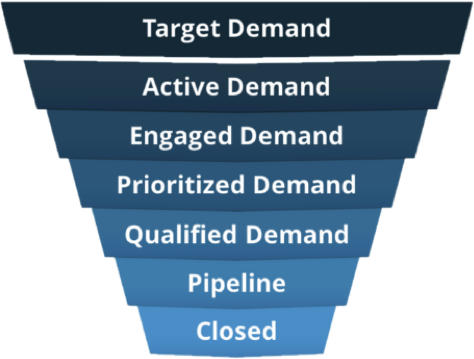In my experience implementing ABM as a SaaS CMO, and then working with other B2B companies as a consultant, I've found 10 key steps that lead to ABM success. More important, I've identified some common mistakes so you can avoid them.
Step 1: Identify your ideal buyer. Start by analyzing your customer base. Look for trends in industry, technology stack, size, stage, triggering events, etc. If you don't have all the data in your CRM, consider conducting interviews with customers or holding thorough discussions with account managers.
Avoid this common mistake: Ignoring the sales cycle and the post-sale aspects. Your biggest customer might also be your longest sales cycle, the neediest, and, consequently, the least profitable. Consider ease of sale, implementation time, change requests, customer satisfaction, and advocacy as key attributes of your ideal buyer.
Step 2: Determine accounts, segmentation, and personas. Ideal buyers typically come from multiple industries, multiple company sizes, and multiple stages, with different personas, etc. Marketing and Sales need to decide on account segmentation and prioritization of the targets and personas.
Avoid this common mistake: Most companies start with industry as the first segmentation criterion. The mistake comes when companies don't prioritize and narrow the scope. Limit your focus to four industries or fewer. You'll be thankful when you start thinking about content!
Step 3: Determine the value prop for the buying personas. To validate priorities and for messaging, identify the compelling reason for each persona to buy from you. That means identifying their pain and how your solution alleviates it. Many companies will use that information to split persona responsibility between Sales and Marketing based on how compelling the value is.
Avoid this common mistake: You may walk into this step with seven personas for each account. The mistake is leaving with seven personas or thinking that you'll treat all personas equally. The exercise to identify the value prop should be used to de-emphasize focus on those personas for which the value proposition is weakest.
Step 4: Get clear on account definition. Defining what an "account" is and aligning the data in the CRM is important. Marketing will be scoring account engagement and notifying Sales when the engagement threshold is reached. Work with Sales to identify whether the 10 locations of a given company are 10 accounts or all part of one account.
Avoid this common mistake: Not getting started on ABM until this step is done! No one has perfect data in their CRM system. The good news is that many of the ABM software solutions can show attribution without relying on CRM data perfection.
Step 5: Decide what Sales and Marketing are prepared to do. Before tiering accounts or purchasing technology, determine what Sales and Marketing are actually prepared to do under the umbrella of account-based marketing and selling. Is the sales team willing to make personalized videos? Should Marketing do targeted IP advertising or website personalization? Is the content team prepared to handle personalized nurture programs? Does the team want to do direct mailers? Should the business/sales development team touch target accounts?
Avoid this common mistake: Everyone agrees to do ABM, but no one changes their past behavior. Whether Marketing continues treating all accounts the same or Sales continues to use the same process for ABM leads as inbound leads, any business-as-usual approach will limit success.
Step 6: Create a strategy for handling accounts at every stage of the demand funnel. That means deciding the "tiers" of accounts and the way that each will be handled as well as handoffs and metrics. Consider each stage of SiriusDecisions' demand unit waterfall and determine Marketing's and Sales's roles in activating an account, building engagement, activating sales, and attributing pipeline. There should be an action and owner for each activity in each stage of the funnel.

SiriusDecisions demand unit waterfall
Avoid this common mistake: Sales and Marketing are still striving for a handoff point. Marketing takes the first few stages of the funnel then throws a qualified account over to Sales to close. The reality of true ABM is that each—Sales and Marketing—plays a role in every stage. Super-scary, but super-effective!
Step 7: Find the target accounts and personas. After setting a strategy for account segmentation, handling, and tiering, you need to identify the accounts in each tier, populate the key contacts, and assign Sales ownership as appropriate. Most companies end up investing in a data provider here to supply the information needed.
Avoid this common mistake: Lack of information is a missed opportunity. Step 1 likely identified some key attributes that you can't find from any data vendor. Do the work (hire an intern, if need be) to find out that information so Marketing and Sales efforts can be as effective as possible.
Step 8: Determine which ABM technology to purchase. Lots of vendors claim they have ABM solutions. The key is to match up the features to how the team plans to execute per steps 5 and 6. There is no bad decision other than not arming the team with the tools to be effective at both execution and attribution.
Avoid this common mistake: Skipping step 5. Without identifying what you need the technology to support, you may end up with lackluster results. Another mistake is not budgeting for technology and drowning in manual work. The whole reason ABM is a thing is because of the available technology to enable it.
Step 9: Create an ABM content strategy, and execute it. Marketing needs a solid strategy for producing the content needed for ABM. Even after prioritization, you are likely dealing with a big matrix of segments and personas. The best approach is to create content using the 90/10 rule. Start with a solid base applicable to all segmentations (90%) and then change out the key graphics, headlines, sidebars, and key terminology (10%) that makes the asset unique for each segment. Repeat for each segment, and you can get a lot of "personalized" content with manageable effort.
Avoid this common mistake: Assigning a different content creator to each key segment gets you unique content, but that is high-cost and high-effort. Worse yet is not investing at all in thought leadership. You may be targeting ideal accounts, but they are still in control of the buying process. You need solid thought leadership to attract and nurture until the account is engaged enough to pass on to Sales.
Step 10: Create an ABS strategy, and execute it. ABM is a big change for sales teams, and they need help to fully understand the ideal buyer as well as their new role of providing value at every stage of the funnel. Sales needs a more personalized approach to engaging with qualified accounts and giving them the personalized materials they need to progress through the sales process.
Avoid this common mistake: It is common that Marketing embraces ABM but Sales doesn't change its approach. Salespeople might be getting better leads from Marketing, but they are calling them just like inbounds and prospecting with the same approach as before. That is an ABM killer! Make sure Sales is on board with its role throughout the demand funnel, and provide the members of the sales team guidance to help them make the transition.




